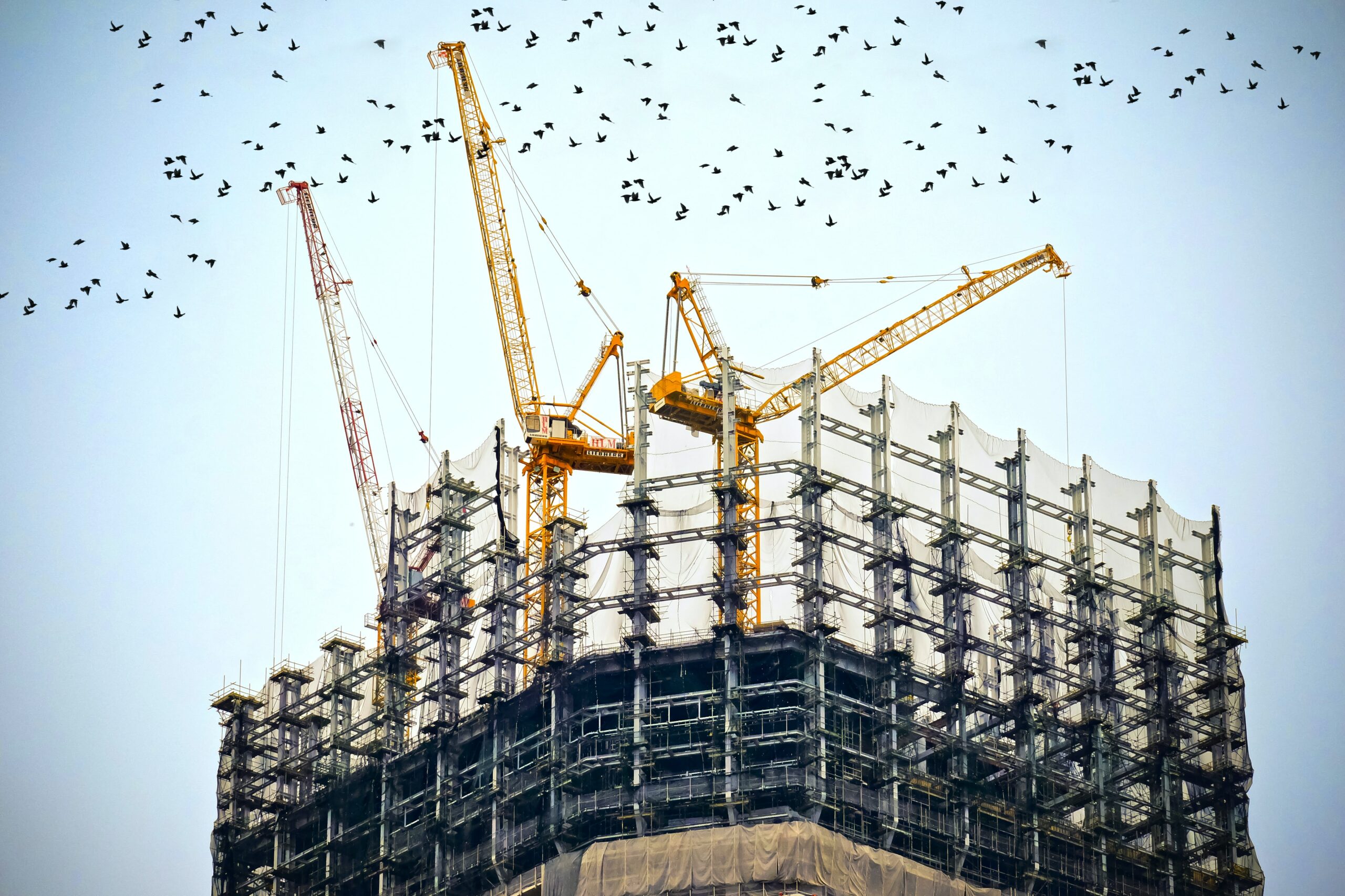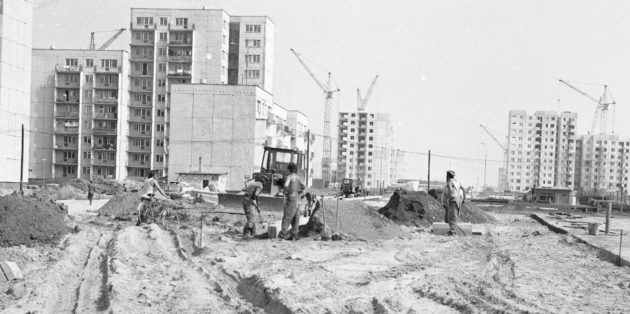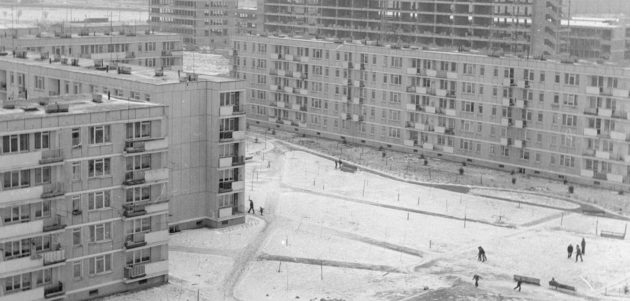
1. Prefabrication in the building industry and contemporary trends
Precast concrete construction is an expanding sector of the construction industry.
This is influenced by the need to ensure durability and very good quality materials, while at the same time there is an obvious need to simplify and speed up the implementation of projects. The increasingly limited space available for building and the increasing degradation of the environment, on the one hand, and the constantly growing demand for residential, industrial and commercial premises, on the other, are also significant. The rapidly evolving labour market is also forcing dynamic change. Labour costs are rising year by year, and the availability of professionals is increasingly limited. Looking at the distribution of investment costs - we are approaching the EU average, where material costs are barely 30%, the remaining 70% being labour costs.
So, how to carry out investments without delays in the current market situation and shortage of skilled workers? How to speed up work on the construction site and how to increase the efficiency of the design process?
Prefabricated construction offers answers to these questions.
Thanks to the latest technology, prefabricated elements meet the most stringent safety requirements and at the same time allow the architect's boldest visions to become reality. Such intelligent plant concepts and customer-optimised solutions are offered, among others, by Vollert GmbH, whose detailed offer can be found in our OFFER section. Vollert is a leading partner providing know-how for concrete plants, construction companies and developers in the field of modern precast concrete production.
In addition, the use of prefabricated solutions enhances the qualities of the building in terms of energy efficiency, innovation and the convenience and speed of construction. These features are extremely important for the investor, as they save space and time. This is crucial in terms of investment financing. The benefits will also be noticed by the user, as the above-mentioned features have an impact on the price of the flat or property, as well as on subsequent usage costs.
2. Concrete as a material of the future
For some years now, concrete as a construction material has dominated modern prefabrication, while the use of timber and steel structures on the scale of overall construction production can be considered low. This is due to the fact that steel and timber are perceived as relatively expensive materials, while concrete is still regarded as an 'affordable' material that is also more malleable and produced in an environmentally friendly manner. Therefore, it can be expected that prefabrication in the construction industry will experience rapid growth in the coming years.
In terms of materials engineering, the development of concretes with a low carbon footprint (so-called zero-emission concretes) is forecast, as well as concretes using innovative binders of mineral origin (geopolymers). Ultra-high strength concretes (so-called BUWW concretes) using reactive powders (RPC) will be developed. Modern concretes with steel dispersed micro-reinforcement (fibre concretes), which do not contain bar reinforcement, as well as concretes containing non-steel main reinforcement (e.g. fibreglass bars, basalt, kelvar) are also of an interesting development.
The use and increase in the proportion of waste and recycled materials, combined with the traditional advantages of prefabrication, has the potential to make prefabrication a technology that is part of sustainable development in construction. It is worth mentioning here the role of precast concrete in the carbon footprint balance of concrete and its components and highlighting its CO2 sequestration potential. In the case of prefabrication, this is quite high, as the surface of precast elements is usually not covered with additional material.
3. How has prefabrication developed in the construction industry in Poland?
In Poland, the beginnings of prefabrication date back to the 19th century, with the opening of the plant in Białe Błoty (which still exists today) in 1897. The first decades of the 20th century and the inter-war period were marked by the development of prefabrication in road and technical infrastructure. In 1939, there were 200 concrete plants in Poland.
The post-war period saw the dynamic development of prefabrication systems, primarily dictated by the increased demand for a large number of low-cost flats in a short space of time as a result of the massive war damage across Europe. This trend also reached Poland, where the first multi-storey residential building was erected in Warsaw as early as 1955, which launched the career of the so-called 'big plate'. This type of construction gave prefabricated concrete a pejorative tint for many years. Between 1970 and 1985, many house factories and prefabrication factories carried out construction according to the precepts of large-panel construction, hurriedly, focusing on quantity rather than quality. This negative image of prefabrication was one of the reasons for the collapse of production during the period of political transition in Poland. It was not until the late 1990s and the opening up of Poland to foreign capital and the exchange of technical ideas with countries where prefabrication is developed on a large scale (Germany, Scandinavia, Benelux) that there was renewed interest in this type of construction.
Initially, the producer market was concentrated around areas related to infrastructure construction (roads, public buildings). Currently, there is an increase in the popularity of prefabrication applications in other areas of construction - including housing. A dynamic development of this area and a gradual shift from traditional construction solutions to prefabricated construction is forecast for the coming years.


Foto: NAC
4. Features of prefabricated construction
Prefabricated construction is fundamentally different from construction using traditional structures and building works.
Its main features are:
◎ much shorter construction time:
Building elements are prefabricated in industrial halls at prefabrication plants, on production lines, using universal production stations where all structural elements are manufactured at a constant ambient temperature. The execution of the project is therefore not dependent on weather factors.
A further benefit arises from the fact that the prefabricated elements acquire their target technical characteristics (e.g. strength) during the production process. This reduces technical interruptions in the erection of the building associated, for example, with the curing of concrete in the structural elements. The installation of ready-made manufactured elements by specialised teams and the use of design solutions that speed up construction time further reduce construction time.
It is estimated that buildings using prefabricated technology are erected around 50% faster than those constructed using traditional technology.
◎ Site size reduced to a minimum:
Prefabricated elements prepared for assembly arrive at the construction site according to strictly planned schedules. The reduction of the construction site is particularly important for urban locations, where the boundaries of the construction site are usually defined by neighbouring buildings. Construction has no impact on the surroundings, and there is no problem of limited space, which can be a challenge when storing construction materials or when delivery trucks have limited access.
Prefabricated construction also has the advantage that it does not generate waste in the same quantities as traditional construction, has low noise emissions and, in addition, does not disturb its surroundings.
◎ modularisation and versatility of construction:
Understood as the use of repetitive building elements in the design and the possibility of industrial production. As a result, investment costs can be reduced.
In addition, the autonomy of individual construction modules makes it possible to assemble/disassemble them without disturbing the other elements.
The range of applications is virtually unlimited. Houses, office buildings, hotels, dormitories, sanatoriums, hospitals and many others are built from prefabricated elements. The number and size of modules can be adapted to individual needs.
An additional advantage is the easy expandability. Modular buildings can easily be extended by adding additional storeys or rooms to the finished building.
◎ high product quality and a provision for safety and durability:
The modules used to erect the structures are manufactured under strictly defined and repeatable conditions. The cross-sections of the individual elements are selected on the basis of precise static calculations. This makes prefabricated buildings an investment that lasts for years.
In addition, when it comes to prefabricated structures, the construction industry pays particular attention to the compliance of products with applicable standards and quality assurance systems. The production of prefabricated elements at the preparation, execution and acceptance stages is subject to strict controls, which minimises the possibility of error. This translates into consistently high product quality.
The use of high-quality materials combined with a technological regime gives the products enhanced performance characteristics. This provides an additional reserve of safety and durability, which usually far exceeds the levels required by regulations and design standards.
◎ The characteristics of concrete as a building material - economic advantages:
With the use of precast elements, the performance characteristics of buildings are also improved: users appreciate above all their durability and safety, including the highest levels of fire safety.
Precast reinforced concrete structures provide excellent protection for the life, health and property of users and have a fire resistance rating of R60 per hour as standard. Concrete is also an excellent thermal mass, which is key to the energy efficiency of buildings: the use of concrete allows for 15 per cent lower energy consumption for heating in winter and up to 6 °C lower temperatures in summer. Concrete is environmentally friendly thanks to, among other things, lower maintenance emissions and 100 per cent recycling. It also provides exceptional sound insulation and high air quality in the building.
Precast concrete houses create a healthier living environment and, given the additional advantages of much shorter construction times and less impact on the site environment, they are an increasingly popular alternative to traditional construction.
◎ construction safety:
Buildings erected using prefabricated technology can additionally boast a high level of safety for a structure subjected to overloading due to weather events (storms, heavy snowfall), random events (seismic shocks) or those resulting from faulty use.
In addition, by designing the roof structure for increased snow load values, the problems and costs associated with clearing snow from roofs can be eliminated. This significantly reduces operating costs, especially in areas where snowfall in the winter months is heavy.
Taking into account the technical and logistical aspects - the number of employees working on prefabricated projects cannot be neglected, which is kept to an absolute minimum. There is no need to use temporary workers or subcontractors who would require additional health and safety training and whose qualifications often differ from those declared.
Thus, the construction site is a safe place to work, where each activity is carried out according to a strict work schedule and where there is no room for haphazardness.
5. Conclusion
Given the scale of applications for prefabricated structures in the construction industry, it is safe to say that this is a technology whose popularity is set to grow year by year. The investment boom in recent years in the area of road and public infrastructure effectively contributes to the growing popularity of solutions based on this construction technique also in other areas of the building industry.
Based on an analysis of the construction market in Poland, experts estimate an upcoming renewed growth in the area of multi-family housing and public infrastructure facilities.
In these predictions, analysts point to:
◎ The speed of erection of prefabricated buildings (advantage of assembly over wet work on site)
◎ The possibility of optimising the quality and material requirements and the energy intensity of manufacturing under conditions of repetitive, certified factory production (advantage over traditional technologies that can undergo random events);
◎ Independence of construction work from weather conditions;
◎ Elimination of the 'weaknesses' of prefabrication from years ago through the implementation of modern durable joints and flexible systems taking into account high aesthetic requirements (hybrid solutions);
◎ The possibility of shaping building blocks with a diverse character and functional programme;
◎ The growing popularity of trends associated with the drive to increase energy efficiency and reduce greenhouse gas emissions and the changes in legislation in these areas;
◎ The simplified process of erecting the building and installing the facilities, which reduces investment time and the share of costs, while ensuring that the quality of the erected buildings is particularly high.
The above argumentation allows us to assume that prefabrication technology will soon do very well in the Polish construction market. Considering also the ecological aspect and the growing popularity of the so-called green building, we share this view, hoping that the experts' predictions will come true in the near future.

You must be logged in to post a comment.